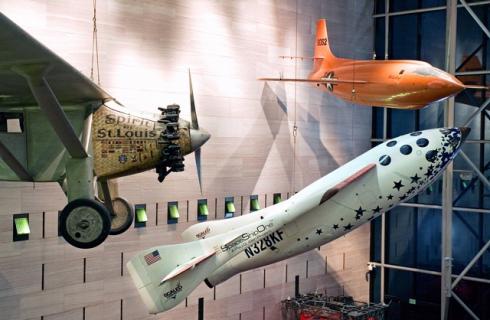
SpaceShipOne, the first privately built and piloted vehicle to reach space, will join the national collection of flight icons on Wednesday, Oct. 5, in a noon donation ceremony at the National Air and Space Museum's flagship building on the National Mall in Washington, D.C.
The spacecraft, 28 feet in length with a 27-foot wingspan, will be prominently displayed in the central Milestones of Flight gallery, home to many of the "firsts" of flight. It will hang between Charles Lindbergh's Spirit of St. Louis and Chuck Yeager's Bell X-1. Microsoft co-founder Paul G. Allen, the sole funder of SpaceShipOne, will make the donation. Burt Rutan, the spacecraft's designer, also will take part.
On June 21, 2004, SpaceShipOne left Earth's atmosphere and entered the weightlessness of space by traveling just above the 62-mile boundary mark (100 km) on an arced, suborbital flight that began with launch from its airplane mothership. It was the first time that private enterprise, and not government, crossed the threshold into human spaceflight.
"It's really gratifying to have the SpaceShipOne project recognized by the Smithsonian when it was just 10 years ago that we first started researching the possibility of private space travel," Allen said. "I saw SpaceShipOne as a great opportunity to demonstrate not just a proof of concept but also demonstrate convincingly that private space exploration could someday be within the reach of individual citizens. Ultimately, SpaceShipOne's presence in the Smithsonian shows once again that America's milestones of flight are not all behind us. It is my hope that SpaceShipOne's new home will enable the millions of National Air and Space museum visitors to view, learn about, be inspired and actively contribute to the next generation of space exploration initiatives."
In fall 2004, SpaceShipOne flew higher than the 62-mile boundary during two more suborbital flights within a period of 14 days, capturing the $10 million Ansari X Prize. The competition was designed to encourage space tourism through development of low-cost, privately owned and operated reusable spacecraft.
The project team was honored with the 2004 Collier Trophy, awarded by the National Aeronautic Association for "greatest achievement in aeronautics or astronautics in America." Allen, Rutan and their team also were awarded the 2004 National Air and Space Museum Trophy for Current Achievement.
"SpaceShipOne represents the next step in traveling beyond our planet," museum director Gen. J.R. "Jack" Dailey said. "Hanging in the Milestones gallery, it will inspire the next generations eager to experience a new accessibility to space. We are fortunate to add this most significant craft to the world's premier flight collection."
Although equipped with three seats, SpaceShipOne was flown into space by solo pilots without passengers. They were awarded the first commercial astronaut wings by the Federal Aviation Administration. SpaceShipOne's design, featuring a hybrid rocket engine, bullet-shaped forward fuselage and splayed wings that pivot up for stable re-entry, will be studied for adaptation to larger vehicles. The mothership, White Knight, will continue to fly as part of spacecraft development projects.
With the exhibition of SpaceShipOne, the museum will introduce a new style of interactive kiosks in the Milestones gallery, allowing visitors to view footage of the spacecraft in flight; explore SpaceShipOne's historical context; hear from its sponsor, designer and pilots; and study its cockpit through seamless 360-degree, high-resolution photography. The kiosks also will feature still photographs and concise labels describing the artifact's accomplishments and design features and the people behind it.
Later this month, the 1903 Wright Flyer—the world's first airplane—will return to its hanging position as the centerpiece of the Milestones gallery following the end of its special eye-level display on the building's second floor. The Flyer will also be the subject of a new interactive kiosk.
The museum's education division will offer talks and hands-on activities as part of a special SpaceShipOne family program day on Saturday, Nov. 19, at the Mall building.
SpaceShipOne will be the fifth Rutan-designed vehicle in the museum's collection. The Mall building's south lobby gallery features Rutan's Voyager aircraft, which in 1986 made the first nonstop, nonrefueled flight around the world.
The National Air and Space Museum building on the Mall is located at Sixth Street and Independence Avenue S.W. The museum's Steven F. Udvar-Hazy Center—which displays one of Rutan's innovative VariEze kit aircraft—is located in Chantilly, Va., near Washington Dulles International Airport. Both facilities are open daily from 10 a.m. until 5:30 p.m. (Closed Dec. 25) Admission is free but there is a $12 fee for parking at the Udvar-Hazy Center.
Shuttle bus service runs between the facilities, with a roundtrip ticket costing $12. (Group discounts are available.)
# # #
SpaceShipOne Specifications
Tail number: N328KF
Length: 28 ft (8.5 m)
Wingspan: 27 ft (8.2 m)
Height: 8 ft 9 in (2.7 m)
Weight, gross: 6,380 lb (2,895 kg)*
Rocket: SpaceDev SD010 Hybrid Motor
Propellants: Rubber (solid) and nitrous oxide (liquid)
Thrust, peak: 16,800 lb (74,730 N)*
Velocity, max.: Mach 3
Manufacturer: Scaled Composites, Mojave, Calif.; rocket motor, SpaceDev, Poway, Calif.
* first space flight
SpaceShipOne Space Flights
June 21, 2004 Mike Melvill pilots SpaceShipOne past 62 miles (100 km) altitude into space
First spaceflight lasts 24 minutes, with 3 minutes of weightlessness
Sept. 29, 2004 Mike Melvill pilots SpaceShipOne to 64 miles (102 km)
Oct. 4, 2004 Brian Binnie pilots SpaceShipOne to 70 miles (112 km)
SpaceShipOne, the first privately built and piloted vehicle to reach space, is now on display in the National Air and Space Museum's building on the National Mall in Washington. It hangs between Charles Lindbergh's Spirit of St. Louis, left, and Chuck Yeager's Bell X-1, above right, in the Boeing Milestones of Flight Hall.
Sole funder Paul G. Allen, left, and designer Burt Rutan celebrate SpaceShipOne's addition to the National Air and Space Museum's Milestones of Flight gallery, Oct. 5, 2005.
National Air and Space Museum Director Gen. J.R. "Jack" Dailey, left, accepts the donation of SpaceShipOne from its sole funder, Paul G. Allen, center, as the vehicle's designer, Burt Rutan, looks on.